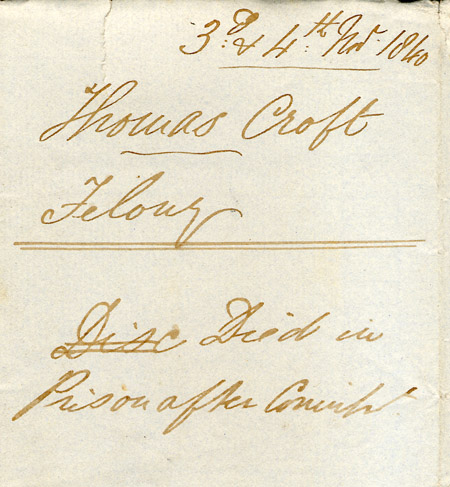Gaol Fever
This month we look at the story behind a group of documents from the Epiphany Session of 1841. The papers relating to the cases against Thomas Carter, Thomas Croft and Amos Bartram, are all annotated 'Prisoner dead'. To have one prisoner die is unusual - the gaol database shows that between 1770 and 1879 only 58 out of approximately 20,000 prisoners, died in gaol of natural causes - therefore to have three in one session seemed worth looking into. [QSR1841/1/5/56].

A search of the gaol database revealed that in fact four prisoners had died between the end of November 1840 and mid February 1841. The surgeons report to the Epiphany sessions reveals the reason. 'A fever of the typhoid type has prevailed in the gaol thro' nearly the whole time since the last report, varying in degrees of virulency from its mildest to its most malignant …in three instances the termination has been fatal. One of these was a healthy boy the other two of weakly constitution one of them afflicted with scrophula in its worst form and of very weak intellect & has been subject to the greatest privation previous to commitment. The disease has now nearly subsided. Wm Waples is ill from the effects of it, his mind is most depressed & he has symptoms of pulmonary disease accompanied with great debility. I feel it my duty to state my approbation of the exemplary manner in which the nurse has discharged his irksome duties thro the whole progress of the Disease & propose to recommend him to the merciful consideration of the magistrates and also that of the turnkey whose attention has been unremitting, he has administered all the wine, brandy &c to the patients so that I am assured they have had what has been ordered…' [QGR1/7] The Quarter Sessions minutes, [QSM34] record how the magistrates rewarded the turnkey, Skinner, and sought the release of Michael Gilman, the nurse. He was released from gaol on the 15th February 1841. [QSM34]

What this report shows is that although death in the gaol was uncommon, illness was not . Many prisoners came into the gaol with conditions that made them vulnerable to disease. Another common illness was Typhus, which was so common in gaols that it was also called 'gaol fever'. In the gaol database the records of William Yates in 1816, John Bodsworth in 1825 and William Dawson in 1827 mention typhus as a cause of death but it is very likely that other prisoners also suffered from it at various times. In his petition of 1821 Arnall Thomas Fayerman MD, who is in prison for debt, claims that 'On the first of the same month (May) yr Petitioner had the misfortune to be attacked with a malignant Typhus Fever which at one period threatened his existence, & from various relapses he has been obliged to keep to his bed during a period of more than two months and at this present time is so reduced as not to be able to stand whilst dressing without support nor even to rise from the bed without assistance - your Petitioner conceives that he never can perfectly recover his health and strength whilst he is confined within the walls of this Prison…'[QSR1821/544].
Typhus has no respect for status and on the 8th of April 1841 it claimed the life of Thomas Gwyn Elger, builder, merchant, architect and former mayor of Bedford [ABT Bedford St Mary's 1841].

Typhus was also responsible for the death of John Howard, the prison reformer, who lived in Cardington but who died in Russia having caught typhus when visiting a prison there. Howard had done much to improve prison conditions in England and, of course, the prison in Bedford in 1841 was a different one to the one described by Howard in his State of PrisonsRecently catalogued material has helped us identified yet another Bridewell site at the junction of Lurke Street and the High Street, which was in use during the 17th century.